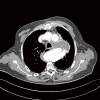Type B aortic dissection: new perspectives
- PMID: 29780721
- PMCID: PMC5945851
- DOI: 10.21037/jovs.2018.03.16
Type B aortic dissection: new perspectives
Abstract
Background: Stanford type B aortic dissection is one of the aortic catastrophes with a high mortality and morbidity that needs immediate or delayed treatment, either surgically or endovascularly. This comprehensive review article addresses the current status of open, endovascular and hybrid treatment options for type B aortic dissections with the focus on new therapeutic perspectives.
Methods: Evaluation of currently available evidence based on randomized and registry data and personal experience.
Results: All type B dissections require prompt medical treatment to prevent aortic rupture. Acute complicated dissections are nowadays treated by endografting to reroute blood flow into the true lumen and promote false lumen thrombosis and future aortic remodeling. In acute uncomplicated situations the position of endografting is less clear and should be further delineated; however, on the long run also in these situations endografting might be protective for future aortic catastrophes in certain patient categories. In the chronic dissection with aneurysm formation of the descending thoracic and/or thoracoabdominal aorta, especially in connective tissue disorders, open surgery offers nowadays the best immediate results with long durability. Thoracic endografting plays only a minor role in these circumstances but branched and fenestrated endografting are very promising techniques. Hybrid techniques can offer the solution for high risk patients that are not suitable for open surgery.
Conclusions: Emergent thoracic endografting is the golden standard for all complicated type B dissections while uncomplicated patients with high-risk features might benefit from endovascular repair. Open surgery is limited for chronic post dissection aneurysms. Aortic surveillance is of paramount importance in all situations.
Keywords: Stanford type B aortic dissection; aorta; open surgery; thoracic endovascular aortic repair (TEVAR); thoracoabdominal aneurysm.
Conflict of interest statement
Conflicts of Interest: The author has no conflicts of interest to declare.
Figures



Similar articles
-
Endovascular Repair of Thoracoabdominal and Arch Aneurysms in Patients with Connective Tissue Disease Using Branched and Fenestrated Devices.Ann Vasc Surg. 2017 Oct;44:158-163. doi: 10.1016/j.avsg.2017.05.013. Epub 2017 May 22. Ann Vasc Surg. 2017. PMID: 28546044
-
Endovascular management of chronic post-dissection aneurysms.Ann Cardiothorac Surg. 2014 May;3(3):307-13. doi: 10.3978/j.issn.2225-319X.2014.04.02. Ann Cardiothorac Surg. 2014. PMID: 24967171 Free PMC article.
-
Total aortic endovascular repair.J Cardiovasc Surg (Torino). 2016 Dec;57(6):784-805. Epub 2016 Sep 21. J Cardiovasc Surg (Torino). 2016. PMID: 27654102 Review.
-
Thoracic Endovascular Aortic Repair for Acute Aortic Dissection.Ann Vasc Dis. 2018 Dec 25;11(4):464-472. doi: 10.3400/avd.ra.18-00127. Ann Vasc Dis. 2018. PMID: 30637000 Free PMC article.
-
Endovascular stent grafting and open surgical replacement for chronic thoracic aortic aneurysms: a systematic review and prospective cohort study.Health Technol Assess. 2022 Jan;26(6):1-166. doi: 10.3310/ABUT7744. Health Technol Assess. 2022. PMID: 35094747
Cited by
-
Endovascular repair of acute complicated type B aortic dissection-systematic review and meta-analysis of long-term survival and reintervention.Ann Cardiothorac Surg. 2021 Nov;10(6):723-730. doi: 10.21037/acs-2021-taes-17. Ann Cardiothorac Surg. 2021. PMID: 34926176 Free PMC article.
-
Endovascular repair of type B aortic dissection with the restrictive bare stent technique: morphologic changes, technique details, and outcomes.Ther Clin Risk Manag. 2018 Oct 12;14:1993-2002. doi: 10.2147/TCRM.S177757. eCollection 2018. Ther Clin Risk Manag. 2018. PMID: 30349278 Free PMC article.
-
Hybrid Approach to Complex Stanford Type B Dissection: Unusual Extra-anatomical Bypass (Aorto- Celiac-Mesenteric Bypass) + Thoracic Endovascular Aortic Repair (TEVAR) + Cholecystectomy.Braz J Cardiovasc Surg. 2021 Aug 6;36(4):561-564. doi: 10.21470/1678-9741-2020-0123. Braz J Cardiovasc Surg. 2021. PMID: 33355790 Free PMC article.
-
Dynamic Changes in the Aorta During the Cardiac Cycle Analyzed by ECG-Gated Computed Tomography.Front Cardiovasc Med. 2022 May 19;9:793722. doi: 10.3389/fcvm.2022.793722. eCollection 2022. Front Cardiovasc Med. 2022. PMID: 35665265 Free PMC article.
-
Chronic Thoracic Aortic Dissection: How to Treat, When to Intervene.Life (Basel). 2022 Sep 28;12(10):1511. doi: 10.3390/life12101511. Life (Basel). 2022. PMID: 36294947 Free PMC article. Review.
References
-
- Wheat MW, Jr, Palmer RF, Bartley TD, et al. Treatment of dissecting aneurysms of the aorta without surgery. J Thorac Cardiovasc Surg 1965;50:364-73. - PubMed
Publication types
LinkOut - more resources
Full Text Sources
Other Literature Sources
